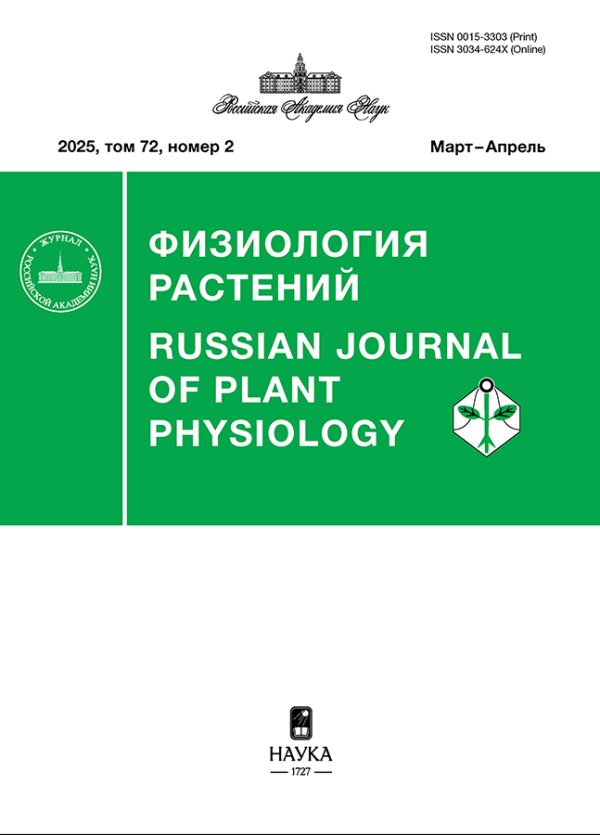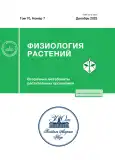The Role of Some Flavonoids and Oleuropein in the Formation of Frost Resistance of Olea europaea L.
- Authors: Paly A.E.1, Gubanova T.B.1
-
Affiliations:
- Nikitsky Botanical Garden, National Science Center, Russian Academy of Sciences
- Issue: Vol 70, No 7 (2023)
- Pages: 875-886
- Section: ЭКСПЕРИМЕНТАЛЬНЫЕ СТАТЬИ
- URL: https://journals.rcsi.science/0015-3303/article/view/233797
- DOI: https://doi.org/10.31857/S0015330323600857
- EDN: https://elibrary.ru/BFTZSQ
- ID: 233797
Cite item
Full Text
Abstract
The degree of participation of oleuropein, rutin, and cinaroside in the processes of formation of winter hardiness and frost resistance in four varieties of European olives Olea europaea L. and subspecies O. europaea subsp. сuspidata (Wall. and G. Don) Cif. was determined in natural and laboratory conditions. To assess the level of stress in the leaves, the proline content was determined, the maximum of which was noted in the weakly resistant subspecies O. europaea subsp. сuspidata. To identify the peculiarities of the accumulation of phenolic substances in natural conditions, the changes in their content in leaves and the average 10-day values of equivalent effective temperatures were compared. In laboratory conditions, the content of phenolic compounds was studied under different cooling modes: 0°C, 6 h → –8°C, 8 h (option 1); 0°С, 6 h → –2°С, 6 h → –8°С, 8 h (option 2); –8°C, 8 h (option 3); –8°C, 12 h (option 4). It was found that keeping shoots at 0°C for 6 h had a positive effect on O. europaea’s winter hardiness, while 6 h of exposure at –2°C led to the development of stress. In the first variant of the experiment, the oleuropein content increased in the resistant variety Nikitskaya. In varieties with an average degree of resistance (Razzo and Ascolano), activation of the biosynthesis of flavonoids and oleuropein was observed. In the weakly resistant Coreggiolo variety, phenolic substances were actively consumed, and trace amounts of oleuropein and no changes in the content of rutin and cynaroside in the subspecies O. europaea subsp. cuspidata, probably, were associated with his less close family ties with O. europaea. It was revealed that, in genotypes with low frost resistance, activation of the synthesis of phenolic compounds occurred only under the influence of a stress factor (–2°C), which did not allow them to adapt in a timely manner, whereas these processes began at earlier stages of cold adaptation in relatively resistant varieties. For the varieties Coreggiolo, Razzo and Ascoliano, prolonged exposure to negative temperatures was a critical factor, while it was lethal for O. europaea subsp. cuspidata (option 4). Differences in the synthesis of phenolic compounds identified under these conditions were are associated not only with the degree of frost resistance but also with the variety specificity of O. europaea genotypes. The obtained data suggested that oleuropein, rutin, and cynaroside are elements of the mechanisms of protection of olive plants from the negative effects of negative temperatures. Apparently, the studied compounds play the role of cryoprotectors and antioxidants and participate in the formation of winter hardiness. The conditions for activating the biosynthesis of phenolic compounds were of great importance. In the highly resistant variety Nikitskaya, their accumulation occurred under the influence of temperatures close to 0°С and directly during the initial damaging temperatures in the unstable varieties Coreggiolo and subspecies O. europaea subsp. сuspidata.
Keywords
About the authors
A. E. Paly
Nikitsky Botanical Garden, National Science Center, Russian Academy of Sciences
Email: gubanova-65@list.ru
Yalta, Russia
T. B. Gubanova
Nikitsky Botanical Garden, National Science Center, Russian Academy of Sciences
Author for correspondence.
Email: gubanova-65@list.ru
Yalta, Russia
References
- Ефимов В.В., Володин Е.М., Анисимов А.Е. Моделирование изменений климата в Черноморском регионе в XXI столетии // Морской гидрофизический журн. 2015. № 2. С. 3. https://doi.org/10.22449/0233-7584-2015-2-3-14
- Туманов И.И. Физиология закаливания и морозостойкости растений. Москва: Наука, 1979. 352 с.
- Петров К.А. Криорезистентность растений: эколого-физиологические и биохимические аспекты. Новосибирск: Изд-во СО РАН, 2016. 275 с.
- Sin’kevich M.S., Naraikina N.V., Trunova T.I. Processes hindering activation of lipid peroxidation in cold-tolerant plants under hypothermia // Russ. J. Plant Physiol. 2011. V. 58. P. 1020. https://doi.org/10.1134/S1021443711050232
- Sharma P., Jha A., Dubey R., Pessarakli M. Reactive oxygen species, oxidative damage, and antioxidative defense mechanism in plants under stressful conditions // J. Bot. 2012. Article ID 217037. https://doi.org/10.1155/2012/217037
- Ortega-Garcıa F., Peragon J. Phenol metabolism in the leaves of the olive tree (Olea europaea L.) cv. Picual, Verdial, Arbequina, and Frantoio during Ripening // J. Agric. Food Chem. 2010. V. 58. P. 12440. https://doi.org/10.1021/jf102827m
- Talhaoui N., Taamalli A., Gomez-Caravaca A.M., Fernandez-Gutierrez A., Segura-Carretero A. Phenolic compounds in olive leaves: analytical determination, biotic and abiotic influence, and health benefits // Food Res. Int. 2015. V. 77. P. 92. https://doi.org/10.1016/j.foodres.2015.09.011
- Petruccelli R., Bartolini G., Ganino T., Zelasco S., Lombardo L., Perri E., Durante M., Bernardi R. Cold stress, freezing adaptation, varietal susceptibility of Olea europaea L. // Plants. 2022. V. 11. P. 1367. https://doi.org/10.3390/plants11101367
- Otero D., Lorini A., Oliveira F., Antunes B., Oliveira R., Zambiazi R. Leaves of Olea europaea L. as a source of oleuropein: characteristics and biological aspects // Res. Soc. Dev. 2021. V. 10:e185101321130. https://doi.org/10.33448/rsd-v10i13.21130
- Alagna F., Geu-Flores F., Kries H., Panara F., Baldoni L., O’Connor S.E., Osbourn A. Identification and characterization of the iridoid synthase involved in oleuropein biosynthesis in olive (Olea europaea) fruits // J. Biol. Chem. 2016. V. 291. P. 5542. https://doi.org/10.1074/jbc.M115.701276
- Panizzi L., Scarpati M.L., Oriente E.G. Structure of the bitter glucoside oleuropein. Note II. // Gazz. Chim. Ital. 1960. V. 90. P. 1449.
- Bonechi C., Donati A., Tamasi G., Pardini A., Rostom H., Leone G., Lamponi S., Consumi M., Magnani A., Rossi C. Chemical characterization of liposomes containing nutraceutical compounds: tyrosol, hydroxytyrosol and oleuropein // Biophys. Chem. 2019. V. 246. P. 25. https://doi.org/10.1016/j.bpc.2019.01.002
- Rao G., Zhang J., Liu X. De novo assembly of a new Olea europaea genome accession using nanopore sequencing // Hortic. Res. 2021. V. 8: 64. https://doi.org/10.1038/s41438-021-00498-y
- Ortega-García F., Peragón J. The response of phenylalanine ammonia-lyase, polyphenol oxidase and phenols to cold stress in the olive tree (Olea europaea L. cv. Picual) // J. Sci. Food Agric. 2009. V. 89. P. 1565. https://doi.org/10.1002/jsfa.3625
- Raimbault A.K., Marie-Alphonsine P.A., Horry J.P., Francois-Haugrin M., Romuald K., Soler A. Polyphenol oxidase and peroxidase expression in four pineapple varieties (Ananas comosus L.) after a chilling injury // J. Agric. Food Chem. 2011. V. 59. P. 342. https://doi.org/10.1021/jf102511z
- Hashempour A., Ghasemnezhad M., Ghazvini R.F., Sohani M.M. Olive (Olea europaea L.) freezing tolerance related to antioxidant enzymes activity during cold acclimation and non acclimation // Acta Physiol. Plant. 2014. V. 36. P. 3231. https://doi.org/10.1007/s11738-014-1689-3
- Mougiou N., Baalbaki B., Doupis G., Kavroulakis N., Poulios S., Vlachonasios K., Koubouris G. The effect of low temperature on physiological, biochemical and flowering functions of olive tree in relation to genotype // Sustainability. 2020. V. 12. P. 10065. https://doi.org/10.3390/su122310065
- Jiang C., Hu W., Lu H., Chen L., Niu E., Zhu S., Shen G. Alterations of phenotype, physiology, and functional substances reveal the chilling-tolerant mechanism in two common Olea europaea cultivars // Front. Plant Sci. 2023. V. 14: 1046719. https://doi.org/10.3389/fpls.2023.1046719
- Afanas'ev I., Dorozhko A.I., Brodskii A., Kostyuk V., Potapovitch A. Chelating and free radical scavenging mechanisms of inhibitory action of Rutin and Qercetin in lipid peroxidation // Biochem. Pharmacol. 1989. V. 38. P. 1763. https://doi.org/10.1016/0006-2952(89)90410-3
- Mechri B., Tekaya M., Hammami M., Chehab H. Effects of drought stress on phenolic accumulation in greenhouse-grown olive trees (Olea europaea) // Biochem. Syst. Ecol. 2020. V. 92: 104112. https://doi.org/10.1016/j.bse.2020.104112
- Genzel F., Dichke M.D., Junker-Frohn L.V., Neuwohner A., Thiele B., Putz A., Usadel B., Wormit A., Wiese-Klinkenberg A. Impact of moderate cold and salt stress on the accumulation of antioxidant flavonoids in the leaves of two capsicum cultivars // J. Agric. Food Chem. 2021. V. 69. P. 6431. https://doi.org/10.1021/acs.jafc.1c00908
- Hodaei M., Rahimmalek M., Arzani A., Talebi M. The effect of water stress on phytochemical accumulation, bioactive compounds and expression of key genes involved in flavonoid biosynthesis in Chrysanthemum morifolium L. // Ind. Crops Prod. 2018. V. 120. P. 295. https://doi.org/10.1016/j.indcrop.2018.04.073
- Палий А.Е., Палий И.Н., Федотова И.А., Мелкозерова Е.А., Цюпка С.Ю., Гребенникова О.А. Динамика фенольных соединений в листьях маслины европейской в холодный период на Южном берегу Крыма // Бюллетень Государственного Никитского ботанического сада. 2019. № 133. С. 51. https://doi.org/10.36305/0513-1634-2019-133-51-56
- Губанова Т.Б., Браилко В.А., Мязина Л.Ф. Зимостойкость некоторых видов семейства Oleaceae в коллекции Никитского ботанического сада // Hortus botanicus. 2018. Т. 13. С. 250. https://doi.org/10.15393/j4.art.2018.5784
- Лищук А.И. Физиологические и биофизические методы в селекции плодовых культур: методические рекомендации. Москва: ВАСХНИЛ, 1991. 58 с.
- Корсакова С.П. Обзор стихийных гидрометеорологических явлений в районе Никитского ботанического cада // Сборник научных трудов Государственного Никитского ботанического сада. 2014. Т. 139. С. 79.
- Врублевська О.О., Катеруша Г.П. Прикладна кліматологія. Конспект лекцій. Дніпропетровськ: Економіка, 2005. 131 с.
- Андрющенко В.К., Саянова В.В., Жученко А.А. Модификация метода определения пролина для выявления засухоустойчивых форм Lycopersicon Tourn // Известия АН Молдавской ССР. Серия биол. и хим. наук. 1981. № 4. С. 55.
- Plazonic A., Bucar F., Males Z., Mornar A., Nigovi B., Kujundzij N. Identification and quantification of flavonoids and phenolic acids in burr parsley (Caucalis platycarpos L.), using high-performance liquid chromatography with diode array detection and electrospray ionization mass spectrometry // Molecules. 2009. V. 14. № 7. P. 2466. https://doi.org/10.3390/molecules14072466
- Mittler R. Oxidative stress, antioxidants and stress tolerance // Trends Plant Sci. 2002. V. 7. P. 405. https://doi.org/10.1016/S1360-1385(02)02312-9
- Haratym W., Weryszko-Chmielewska E., Konarska A. Microstructural and histochemical analysis of aboveground organs of Centaurea cyanus used in herbal medicine // Protoplasma. 2020. V. 257. P. 285. https://doi.org/10.1007/s00709-019-01437-4
- Зайцева С.М., Калашникова Е.А., Киракосян Р.Н., Берковская И.А., Белевцова А.С., Щербакова А.А. Гистохимическое определение локализации флавоноидов в эпидермальных тканях лекарственных растений Dioscorеa caucasica Lipsky, Taxus canadensis Marsh, Ginkgo biloba, Helianthus annuus L. // Ветеринария, зоотехния и биотехнология. 2022. Т. 2. С. 66. https://doi.org/10.36871/vet.zoo.bio.202202009
- Korsakova S., Korsakov P. Features development of olive trees during the growing season in the Southern coast of the Crimea // BIO Web Conf. 2021. V. 38: 00060. https://doi.org/10.1051/bioconf/20213800060
- Запрометов М.Н. О функциональной роли фенольных соединений в растениях // Физиология растений. 1992. Т. 39. С. 1197.
- Fahimirad S., Karimzadeh G., Ghanati F. Cold-induced changes of antioxidant enzymes activity and lipid peroxidation in two canola (Brassica napus L.) cultivars // J. Plant Physiol. Breed. 2013. V. 3. P. 1.
- Olenichenko N.A., Ossipov V.I., Zagoskina N.V. Effect of cold hardening on the phenolic complex of winter wheat leaves // Russ. J. Plant Physiol. 2006. V. 53. P. 495. https://doi.org/10.1134/S1021443706040108
- Janas K.M., Cvikrova M., Palagiewicz A., Szafranska K., Posmyk M.M. Constitutive elevated accumulation of phenylpropanoids in soybean roots at low temperature // Plant Sci. 2002. V. 163. P. 369. https://doi.org/10.1016/S0168-9452(02)00136-X
- Корсакова С.П., Корсаков П.Б. Динамика временных границ климатических сезонов на Южном берегу Крыма в условиях изменения климата // Бюллетень Государственного Никитского ботанического сада. 2018. № 127. С. 100. https://doi.org/10.25684/NBG.boolt.127.2018.15
- Lopez-Bernal A., Garcia-Tejera O., Testi L., Orgaz F., Villalobos F. Studying and modelling winter dormancy in olive trees // Agric. For. Meteorol. 2020. V. 280: 107776.https://doi.org/10.1016/j.agrformet.2019.107776
Supplementary files















